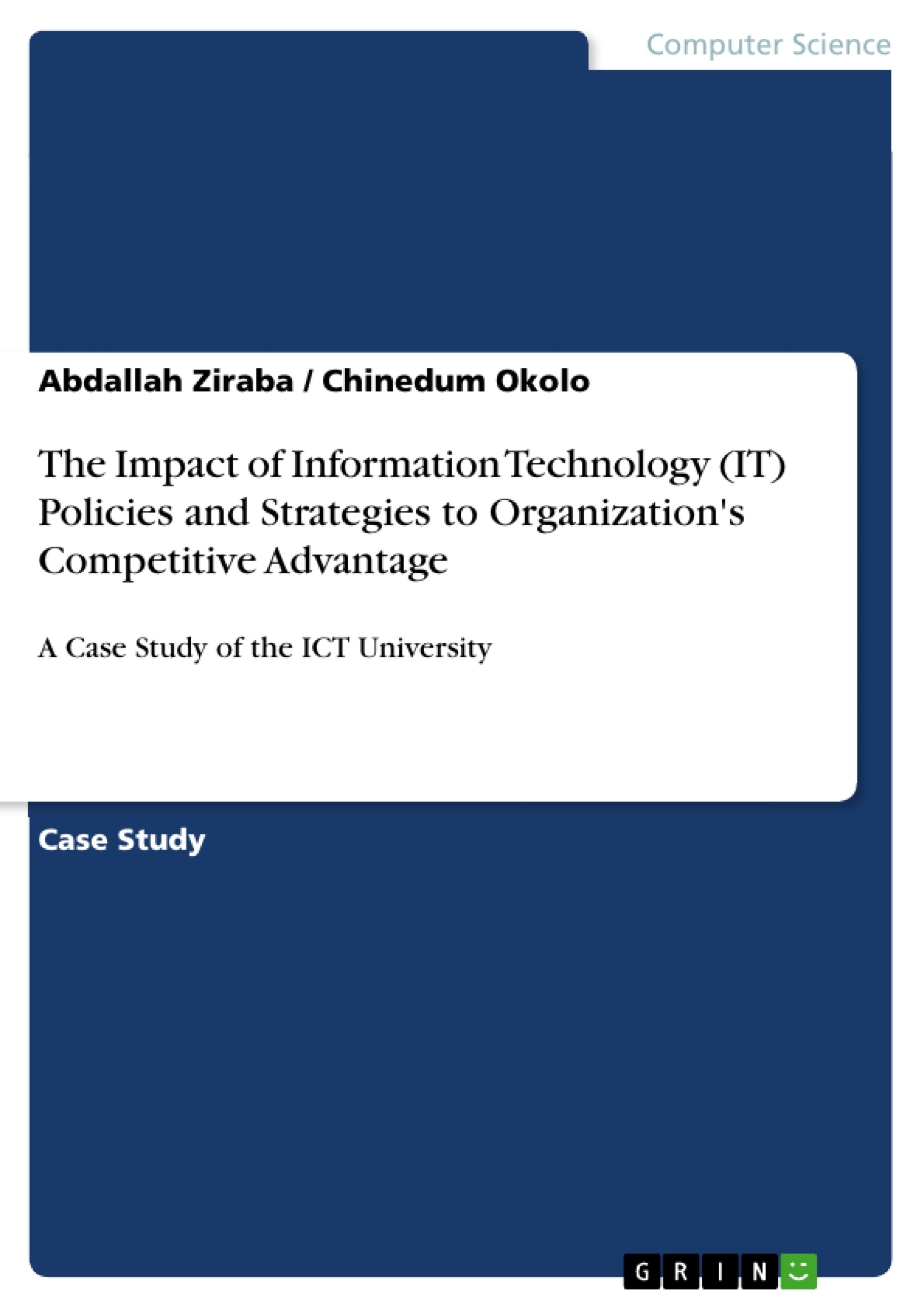The paper aims at reviewing the importance and various aspects of Information Technology (IT) policy and strategy formulation as well as the impacts of IT policy and strategy for competitive advantage in the organization. The paper reveals that information technology which is a vital tool used for a more effective and efficient communication is advancing at a great pace at and poses a great threat to organizations and employees right to privacy. The paper upholds that IT policy formulation is one of the best ways, to ensure effective IT standards, procedures, that protects organizational IT resources and controls information sharing. The article goes further to show how IT strategy formulation helps the organization (using the Information and Communication Technology University as a case study) to achieve its set objectives through policies which control mission-critical activities. The Authors reviewed a total of 23 peer-reviewed articles from prominent journals. The article addressed the following sections: The topic, abstract, introduction, literature review as well as summarized concepts of IT policy and strategy, Importance of IT strategy for business competitive advantage, discussions of organizational IT strategies with case study, impacts of IT policy and strategy on organization, purpose of IT policy and strategy in the organization, summary and conclusions/ findings. The study revealed that IT strategy formulation offers six key advantages which are; Creation of new IT services or products, Improved or quick decision making, Customer and supplier intimacy, Operational excellence, Competitive advantage, and Business survival. The ICT University was used as a case study. The study concluded that IT policies and strategies must align with the organization’s vision, mission-critical activities, in order to realize set objectives. It was recommended that any organization that succeed, should first set visions, adopt IT strategies, formulate IT policies in order to have a good sense of business direction for competitive advantage.
Inhaltsverzeichnis (Table of Contents)
- ABSTRACT
- INTRODUCTION
- IMPORTANCE OF IT STRATEGY FOR COMPETITIVE ADVANTAGE
- DISCUSSIONS ON ORGANIZATIONAL IT STRATEGY (A CASE THE ICT UNIVERSITY)
- IMPACTS OF IT POLICY AND STRATEGY ON AN ORGANIZATION
- PURPOSE OF IT POLICY AND STRATEGY IN THE ORGANIZATION
- SUMMARY
- CONCLUSION
- REFERENCES
Zielsetzung und Themenschwerpunkte (Objectives and Key Themes)
This paper aims to analyze the significance and diverse aspects of Information Technology (IT) policy and strategy formulation, along with their impact on an organization's competitive advantage. The study explores the role of IT in fostering effective and efficient communication, while simultaneously addressing the potential threats it poses to organizational privacy. Furthermore, it investigates the importance of IT policy in establishing robust IT standards and procedures to safeguard organizational resources and control information sharing.
- The crucial role of IT policy and strategy in enhancing organizational competitiveness
- The influence of IT on communication efficiency and potential threats to organizational privacy
- The significance of IT policy in establishing IT standards, procedures, and controls for information sharing
- The application of IT strategy in achieving organizational objectives through a case study of the ICT University
- The benefits of IT strategy formulation for achieving competitive advantage, including operational excellence and business survival
Zusammenfassung der Kapitel (Chapter Summaries)
- ABSTRACT: Provides an overview of the paper's objectives, methodology, and key findings. The study highlights the importance of IT policy and strategy in achieving competitive advantage, drawing upon a case study of the ICT University.
- INTRODUCTION: Introduces the significance of IT in today's business environment, emphasizing its role in information sharing and the need for strategic IT policies to protect organizational resources. The chapter also underscores the alignment of IT policies with organizational vision and mission.
- IMPORTANCE OF IT STRATEGY FOR COMPETITIVE ADVANTAGE: Explores the key advantages of IT strategy formulation, including the creation of new IT services, improved decision-making, enhanced customer and supplier intimacy, operational excellence, competitive advantage, and business survival.
- DISCUSSIONS ON ORGANIZATIONAL IT STRATEGY (A CASE THE ICT UNIVERSITY): Provides a detailed examination of the ICT University's IT strategy, highlighting the institution's use of IT to achieve its objectives and enhance its competitive position. The chapter also discusses the university's IT policies and procedures.
Schlüsselwörter (Keywords)
The main keywords and focus topics of the text include IT policy, IT strategy, competitive advantage, organizational resources, information sharing, privacy, communication, ICT University, and case study. These terms encapsulate the core concepts and research focus of the paper, exploring the impact of IT policies and strategies on organizational success.
- Quote paper
- Abdallah Ziraba (Author), Chinedum Okolo (Author), 2018, The Impact of Information Technology (IT) Policies and Strategies to Organization's Competitive Advantage, Munich, GRIN Verlag, https://www.grin.com/document/421249



